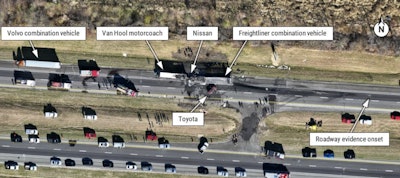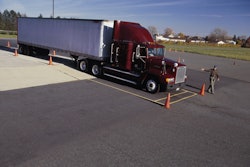Trucking news and briefs for Tuesday, Oct. 7, 2025:
TCA President Jim Ward announces retirement
Truckload Carriers Association President Jim Ward will retire in the coming months, following a highly successful tenure leading the organization, TCA announced Oct. 2. In addition to serving as TCA President, Ward was previously the president and CEO of D.M. Bowman (CCJ Top 250, No. 229).
Ward’s retirement is the culmination of a thoughtful succession process and a distinguished career of service to the trucking industry, TCA noted.
 Jim Ward
Jim Ward
“This decision has been in the works for some time, and I’m incredibly proud of what we’ve accomplished together,” said Ward. “TCA is strong, its future is bright, and I look forward to watching the Association continue to grow and flourish in the years ahead.”
In preparation for this transition, TCA has established a search committee tasked with identifying Ward’s successor. The committee is committed to selecting a leader who will carry forward TCA’s mission and values, while advancing growth, strengthening relationships in Washington and embracing innovation and technology.
“Jim’s leadership has had a lasting impact on TCA and the entire truckload industry,” said Karen Smerchek, TCA Chairman and President of Veriha Trucking. “This transition reflects the next step in a carefully considered succession plan, and we are deeply grateful for the stability and strength Jim has brought to the Association.”
The search process is now underway. Interested candidates are encouraged to submit resumes and cover letters to [email protected]. The job description and additional information can be found here.
NTSB pushes for forward collision warning, AEBs in fatal truck-bus crash investigation report
A fatal 2023 crash involving a tractor-trailer, a motorcoach carrying high school band students, and other vehicles in Ohio was the result of the involved truck driver’s “inattention and failure to respond, for unknown reasons, to the visibly slow-moving vehicles, including a motorcoach, at the end of a traffic queue caused by an earlier minor crash,” according to a final report released recently by the National Transportation Safety Board.
The crash occurred on Nov. 14, 2023, along I-70 near Etna, Ohio, when a 2019 Freightliner Cascadia and 2017 Strickland tractor-trailer combination, operated by Mid-State Systems Inc., came upon slowed traffic caused by an earlier minor crash. The truck did not slow down and crashed into the line of traffic, causing a chain-reaction collision and a post-crash fire that involved five vehicles including two passenger vehicles, a motorcoach, and a second tractor-trailer.
 The aerial view of the crash scene shows where the vehicles involved in the crash came to rest.NTSB
The aerial view of the crash scene shows where the vehicles involved in the crash came to rest.NTSB
NTSB added that immediately before the crash, the tractor-trailer that caused the crash was traveling about 72 mph, and the other four vehicles were traveling between 3 and 15 mph.
As a result of the crash, three motorcoach passengers and three passenger vehicle occupants were fatally injured. The driver and two passengers of the motorcoach, as well as the driver of a passenger vehicle, were seriously injured. The driver of the Freightliner and 36 motorcoach passengers sustained minor injuries.
NTSB’s investigation found that “salient cues, in the form of slowing traffic in both lanes and illuminated brake lights, were present at the end of the traffic queue to inform the truck driver of the need to slow his vehicle.” The driver, however, took no evasive action “consistent with being inattentive to the forward roadway, but the reason for his inattention was unknown.”
In addition to the primary probably cause of the crash being the truck driver’s inattention, other contributing factors included a lack of an in-cab driver monitoring system to return the driver’s attention to the road, among others.
As a result of the investigation, NTSB issued a number of recommendations to federal agencies, trucking organizations and others to improve highway safety. Among recommendations that could, if implemented, affect truck drivers and the trucking industry include one for the National Highway Traffic Safety Administration to require driver monitoring systems that detect risky driving behavior, including but not limited to driver inattention, and that provide instantaneous feedback that communicates to the driver through multimodal signaling the need to bring attention back to the driving task.
Another recommendation issued to the Owner-Operator Independent Drivers Association, American Trucking Associations, International Brotherhood of Teamsters and others was to promote to their members the potential safety benefits of in-cab alert technology to encourage owner-operators and carriers to use these systems. These groups were also recommended to promote the benefits of collision avoidance technologies including forward collision warning (FCW), automatic emergency braking (AEB), and driver monitoring systems, along with the risks associated with opting out of these technologies.
NTSB also reiterated previously-issued recommendations to NHTSA to complete the development and application of performance standards for the assessment of forward collision avoidance systems in commercial vehicles, and to revise Federal Motor Vehicle Safety Standard 302 to adopt the more rigorous performance standards for interior flammability and smoke emissions characteristics already in use for commercial aviation and rail.
[Related: NTSB releases details around fatal I-70 crash between truck, bus]
Canadian province shuts down trucking schools, fleets for unsafe practices
With the United States focusing much of its attention on states’ non-domiciled CDL issuance practices in an effort to improve highway safety, our neighbors to the north have set their sights on CDL schools and trucking companies.
The province of Alberta’s government announced Oct. 3 that it’s “cracking down on unsafe commercial driver training schools and bad actors in the trucking industry to keep roads safe.”
Through inspections, audits and targeted investigations, Alberta’s government has ordered the closure of five truck driver training schools and has issued 39 disciplinary letters, more than $100,000 in administrative penalties, six corrective action plans, revoked 12 instructor licenses, and sent four warning letters to driver examiners.
[Related: DOT hopes to force 194,000 non-domiciled CDL holders out of trucking]
Additionally, 13 commercial trucking companies have also been removed from Alberta’s roads due to poor on-road performance, unsafe equipment or failure to meet mandatory safety standards, the provincial government said. Of those 13, seven were identified as “chameleon” carriers that tried to avoid regulatory oversight by changing names, creating new entities or relocating operations across jurisdictions.
Alberta said it’s working with federal and provincial/territorial partners to strengthen enforcement across jurisdictions including addressing chameleon carriers. Work is also underway by the Canadian Council of Motor Transport Administrators to develop a national database to address the loophole that carriers currently use to exploit gaps in interprovincial data sharing and enforcement.
Alberta is also targeting the misclassified driver scheme known as Drivers Inc., where companies hire drivers as independent contractors to avoid payroll taxes and benefits.
“These drivers often lack proper training and oversight and are vulnerable to exploitation,” the Alberta government said. “In July 2025, a week-long commercial driver status and classification check stop revealed that 20% of the 195 drivers stopped were suspected of being misclassified, including several temporary foreign workers.”
[Related: Joint trucking/ICE enforcement effort leads to 130 arrests]













